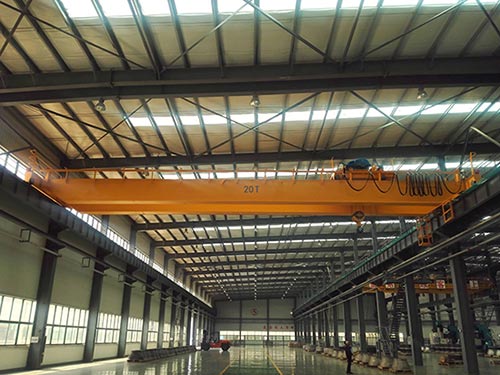


Let’s explore the different types of spreader beams commonly used with these cranes.
In industrial lifting, overhead cranes are indispensable for handling heavy loads efficiently and safely. Among the many components of these cranes, the spreader beam plays a crucial role in ensuring that loads are lifted and transported evenly. For double girder overhead cranes, spreader beams come in various designs to accommodate specific lifting requirements. Let’s explore the different types of spreader beams commonly used with these cranes.
A standard spreader beam is one of the most commonly used in double girder overhead cranes. It is designed with a straightforward structure that consists of two lifting points (or shackles) on the beam itself. These lifting points are connected by the beam’s horizontal structure, which is often fabricated from high-strength steel. The purpose of the standard spreader beam is to distribute the load evenly across the lifting points, minimizing the risk of strain or damage to the load during lifting.
These spreader beams are typically used for handling loads that are symmetrical, like bundles of steel plates or concrete beams, where the load’s weight is distributed uniformly. They are ideal for medium-duty operations and can be custom-designed to meet specific span and capacity requirements.
As the name suggests, adjustable spreader beams allow for modifications in the distance between the lifting points. This type of spreader beam provides versatility by enabling adjustments to accommodate different load sizes and shapes. This is particularly useful in situations where the overhead crane for sale needs to lift loads of varying dimensions.
The adjustable feature of this spreader beam makes it highly adaptable, allowing it to handle a wider range of lifting operations. Adjustable spreader beams are commonly used in industries such as construction, where loads come in varying shapes and sizes. The ability to adjust the span ensures that the load is always lifted securely, with minimal risk of damage or imbalance.
Fixed spreader beams are designed for a specific load capacity and span. Unlike adjustable beams, these spreader beams cannot be altered once they are constructed. They are made to handle a particular load and are ideal for repetitive tasks where the size of the load doesn’t vary significantly.
Fixed spreader beams are typically used for consistent lifting operations involving the same type of load. This makes them highly cost-effective for applications that require a specific set of lifting criteria. For example, lifting steel coils or other uniform materials in a warehouse might call for a fixed spreader beam, as the dimensions of the load are predictable and consistent.
Box spreader beams are a more robust variation that provides additional strength and stability when lifting extremely heavy or awkwardly shaped loads. The “box” structure refers to the additional reinforcement that surrounds the beam, making it stiffer and less prone to flexing or bending under heavy loads.
These types of spreader beams are used in heavy-duty lifting applications, including the handling of large machinery, heavy equipment, or bulky construction materials. The extra strength provided by the box design ensures that the load is held securely, even in the most demanding conditions.
While similar to spreader beams, lifting beams are a different category of load-handling equipment. Lifting beams are designed to lift a single load point from the center of the beam, while spreader beams generally distribute the load across multiple lifting points.
Lifting beams are often used when the load needs to be lifted from a single center point, such as lifting a large, unbalanced object that cannot be divided into equal lifting points. They are more specialized in their design and are often used in highly specialized applications like lifting wind turbine blades or offshore equipment.
Choosing the right type of spreader beam for a double girder overhead crane depends on the nature of the load, the lifting environment, and the frequency of use. Standard, adjustable, fixed, box, and lifting beams each offer distinct advantages, making them suitable for different lifting operations. Understanding these options will help ensure that your lifting tasks are carried out safely and efficiently. Whether for routine or heavy-duty operations, selecting the correct spreader beam is critical for maximizing crane performance and safeguarding the integrity of both the load and the crane.
